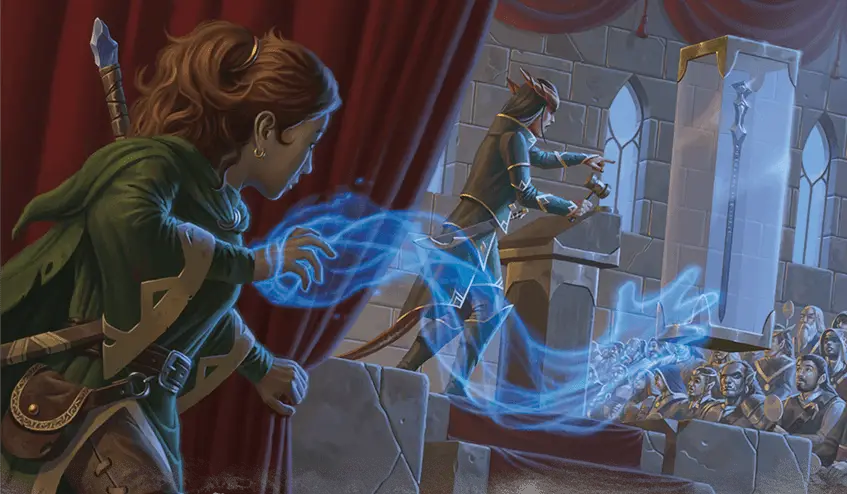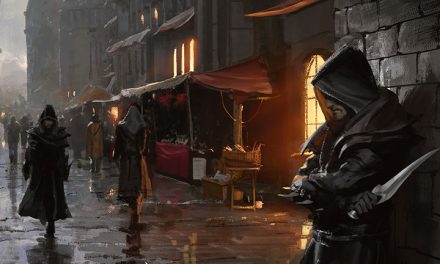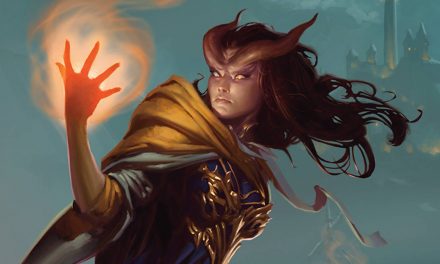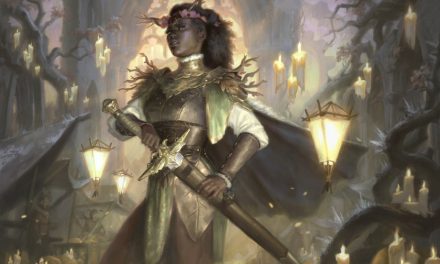The Arcane Trickster Rogue archetype is a wonderful example of what a good subclass should do in D&D 5e.
This archetype plays to the existing strengths of the Rogue class while also expanding their abilities to create something versatile and fun.
Whether your Rogue is looking to add utility to the party, just cause some trouble, or maybe a bit of both, they’ll have no shortage of opportunities to shine in any campaign!
So if you’re ready to see what’s in this Rogue’s bag of tricks, let’s jump right into this Arcane Trickster Rogue Guide for D&D 5e.
What is the Arcane Trickster Rogue?
The Arcane Trickster is a Rogue who uses a mix of agility and magic to achieve their goals.
Plenty of foes have dismissed these tricksters at their own peril. These Rogues show that their skills are more than just the sum of their parts!
Primarily using Enchantment and Illusion magic to supplement their roguish skills, Arcane Tricksters have a knack for turning situations upside down. The chaos that they create then provides ample room for the trickster to operate freely!
You can always count on an Arcane Trickster to find unconventional or unexpected solutions to problems!
Role in the Party
The Arcane Trickster is capable of putting out some fantastic damage thanks to the Rogue’s Sneak Attack ability. Because they incorporate Enchantment and Illusion magic into their technique, they rarely have a difficult time getting a chance to use their Sneak Attack!
Of course, that same magic is what makes the Arcane Trickster so useful as a Controller as well. Enemies will be so busy handling the trickster’s illusions or blinded by their enchantments that they won’t be able to focus on the party!
Lastly, it goes without saying that the Arcane Trickster, like all Rogues, is great for finding and dealing with traps. Though Mage Hand and an increased reliance on the Intelligence score mean that they may even have an easier time than other Rogues!
To learn more about character roles in the party, check out our other article on party composition!
Arcane Trickster Spellcasting Guide
The thing that immediately sets the Arcane Trickster apart from the other Rogue archetypes is their ability to cast spells.
You will primarily be relying on spells that are level 1 through 3. At levels 19 and 20, you have a level 4 spell slot.
While the Arcane Trickster won’t be keeping up with the vast majority of other spellcasting classes, they get a ton of utility out of the spells that they do get.
Fortunately, you will be using the Wizard spell list for your selection. This means that you have a large amount of very good spells to pick from! Because you will be using your Intelligence for spellcasting, you’ll want to make sure that your Arcane Trickster has a good Intelligence score!
Arcane Trickster Spell Selection
At level 20, you will have 13 known spells. 4 of these can be from any school that you would like, but the rest must be Enchantment or Illusion spells.
You will also start out with 3 cantrips in total, but will gain a fourth one at level 10. One of these must be Mage Hand, which you will be getting a lot of use out of.
Look for options that give you extra utility like Message or Minor Illusion. If you want to keep some extra damage in your back pocket, you might pick up Booming Blade, Toll the Dead or Fire Bolt.
When choosing your spells, you still want to prioritize utility over outright damage. Spells that aid you in deceiving others or enhance your sneakiness are simply more valuable. Though it’s not necessarily a bad thing to keep a damage spell just in case.
Some standout options include Disguise Self, Invisibility, and Silent Image.
The spells that the Arcane Trickster learns at levels 8, 14, and 20 do not need to be Enchantment or Illusion. All of their other spells must be from these schools.
Of the three spells that the Arcane Trickster knows at level 3, two must be Enchantment or Illusion spells.
You can replace your spells known when you level up with other options from the Wizard spell list. The new spell must be of a level that you can cast and must be either Enchantment or Illusion. It can be from a different school if you are replacing a spell that you gained at level 8, 14, or 20.
The Arcane Trickster’s Spellcasting table can be found in the Player’s Handbook on page 98. This will show you the spells and cantrips that your characters knows and can cast per level.
You’ll also want to check out my article on the Best Spells for Arcane Tricksters by Level!
Arcane Trickster Abilities
In addition to spellcasting, the Arcane Trickster Rogue subclass gains several abilities that help them own the battlefield. Causing havoc with their Mage Hand, inflicting disadvantage on enemies, and outright stealing spells are tricks of their trade!
Mage Hand Legerdemain
Mage Hand is largely the core feature of the Arcane Trickster archetype. Not only is the hand invisible (unlike the normal spell), but it gets extra abilities as well!
This use of Mage Hand allows the hand to stow objects in containers that are held by other creatures. Similarly, it can also retrieve objects in this way.
This is great for pickpocketing and for stashing items on others. Successful Sleight of Hand checks against their Perception checks will help you go completely unnoticed. Worst case scenario: you can very likely talk your way out with a Deception check if they suspect you!
Plus, the finer control that the Arcane Trickster has with their Mage Hand allows them to pick locks and disarm traps at range. Because very few traps will affect you when you’re 30 feet away, this means that it’s far less likely that you’ll find yourself getting blown up by a particularly clever trap! That’s always a good thing!
Then, the deal gets even sweeter by allowing you to use the bonus action from the Rogue’s Cunning Action feature to control the hand. This is some wonderful action economy that helps to keep the Arcane Trickster having plenty of options.
Mage Hand Legerdemain is a fantastically useful ability with a seemingly limitless amount of applications. You’ll be using this constantly!
Magical Ambush
The Arcane Trickster’s next ability is Magical Ambush and you get this at level 9.
Up to this point, you have mostly used your spellcasting for trickery, utility, and maybe a bit of damage. But level 9 is where the gloves come off!
If you are hidden from a creature when you cast a spell on it, Magical Ambush gives it disadvantage on any saving throw that it makes against the spell this turn.
This might seem small, but it’s incredibly powerful.
If you are casting a spell that requires a saving throw that the target is already weaker in, they may never recover! On the other hand, having disadvantage on a saving throw for an ability that a creature typically excels at can easily give you the edge you need to severely weaken them.
Check out this other article on Advantage & Disadvantage to learn more about how this works!
In most situations, using your Cunning Action to Hide should work well. Hiding behind a pillar, in a bush, or somewhere else can let you stay safe while you cast spells that the enemies will have a very difficult time resisting.
Versatile Trickster
At level 13, the Arcane Trickster Rogue gets a nifty buff to their Mage Hand.
While your Mage Hand has been great for picking locks, disarming traps, and rifling through pockets up to this point, it can now be used to distract your enemies.
Using a bonus action, you can have the hand distract an enemy that is within 5 feet of it. This gives you advantage on your attack rolls against that creature until the end of your turn.
With the Versatile Trickster ability, you have another reliable way of gaining advantage to use your Sneak Attack ability.
Combine that with the tips from this Sneak Attack Guide!
You will want to be mindful of this ability’s effect on your action economy. Using your bonus action to gain advantage on your attack prevents you from using your Cunning Action to Hide or Disengage on your turn.
Realistically, you probably aren’t making many attacks that aren’t at advantage or don’t benefit from your Sneak Attack at this point. Whatever situations would have prevented this before, you can now overcome with your Mage Hand and Versatile Trickster.
Spell Thief
Upon hitting level 17, the Arcane Trickster gets their final subclass ability: Spell Thief.
With this ability, the Arcane Trickster uses their reaction when a creature casts a spell that either targets them or includes them in its area of effect. The creature must now make a saving throw with its spellcasting ability modifier. The DC for this saving throw is equal to your spell save DC.
If the creature fails this saving throw, you negate the spell. But it gets so much better than that…
You don’t just negate the spell, you outright steal it!
If the spell is at least level 1 and is of a level that you can cast, you know the spell and can cast it with your own spell slots for the next 8 hours. Meanwhile, the creature can’t cast that spell again until that 8 hours has passed! This works even if it’s not a Wizard spell!
Not only can this get you a powerful spell that you might not have been able to take otherwise, but it could very likely save you from something particularly nasty.
Even if you aren’t able to then use the spell yourself, it’s still a clutch counterspell in your back pocket. If you can use the spell, be sure to tell the creature where you got it from!
Connections
Arcane Tricksters occupy a weird, niche overlap between Rogues and Wizards. This means that whatever spurred them onto their current path is sure to be an interesting story!
Perhaps they were an urchin on the streets who broke into a wizard’s home one night in search of valuables to sell. Picking up some books on magic, they came to realize that they had an aptitude for it.
What if the Wizard allowed the Rogue to “break into” their home after noticing a spark of magical potential in them? This might form the start of a type of apprenticeship.
Whether self-taught or through studying under someone, the Arcane Trickster can be easily tied into the world through organizations both magical and… not strictly legal…
I love how Sam Riegel in Critical Role ties his Arcane Trickster, Nott the Brave, into the story.
While the character is certainly clever, she is closely connected to the party’s wizard, Caleb, who often helps teach her new spells and abilities. The two spend much of the early games of season 2 running schemes and make a fantastic duo.
The Arcane Trickster’s very nature prompts questions that will naturally lead to a very interesting backstory for any character.
Is the Arcane Trickster Rogue in D&D 5e Good?
Final verdict on the Arcane Trickster Rogue: it’s not good… it’s fantastic!
Seriously, this is one of the most impressive Rogue archetypes. Its abilities perfectly add to the Rogue’s role in the party while also expanding how that character is played in interesting ways.
Interesting and useful mechanics? Check!
Roleplay potential? Check!
Not only do you get all of the fun shenanigans that all Rogues enjoy, but you also get to expand on your bag of tricks with the help of some handy-dandy magic.
Players who love finding creative approaches to situations, combat or otherwise, will be especially drawn to this class!
P.S. Don’t forget to also read my Complete Guide to the Rogue in 5e!
Conclusion – The Arcane Trickster Rogue in D&D 5e
It’s hard to overstate how impressive the Arcane Trickster archetype is. Not only is it incredibly useful, it’s also a blast to play!
Enchantment and Illusion spells have a tendency to be able to very quickly change a situation, so they’re great to have. Adding in the use of Mage Hand Legerdemain and how easy it is to consistently get advantage in the mid-levels, the Arcane Trickster provides incredible amounts of value for a party.
Much like with the Druid subclasses ranking, I’m reserving all judgement until I’ve written guides for every Rogue subclass that has been released so far.
That said… I’m pretty sure we all have a solid idea where this one will fall in that ranking…
Want to be notified when the Rogue ranking article (and other super-awesome content!) goes live?
Sign up for the Tabletop Joab newsletter below!
Update: You can view the complete ranking here!






![Can Druids Wear Metal Armor? [Answered]](https://tabletopjoab.com/wp-content/uploads/2021/01/elf-druid-dungeons-and-dragons-440x264.jpg)


